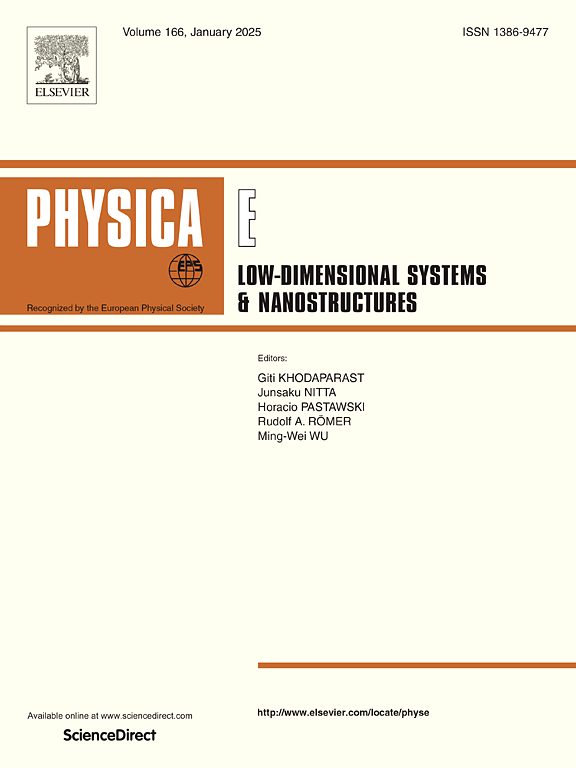Second harmonic generation and electronic properties in the septuple-atomic-layer MA2Z4 family
IF 2.9
3区 物理与天体物理
Q3 NANOSCIENCE & NANOTECHNOLOGY
Physica E-low-dimensional Systems & Nanostructures
Pub Date : 2025-02-07
DOI:10.1016/j.physe.2025.116202
引用次数: 0
Abstract
Two-dimensional (2D) Janus monolayers represent a novel class of materials characterized by their unique structures and exceptional properties. The excitonic characteristics, along with the linear and nonlinear optical responses of the 2D MA2Z4 family, have been systematically investigated through first-principles calculations. The findings indicate that monolayers of MSiGeN4 (M = Mo or W) exhibit a pronounced second harmonic generation (SHG) response and notable infrared transmission capabilities, due to the breaking of mirror symmetry in these materials. A comparative analysis of the SHG response of intrinsic MSi2N4 (M = Mo and W) monolayers demonstrates that Janus MSiGeN4 (M = Mo and W) monolayers significantly enhance the SHG response, with enhancement factors of 5.5 and 3.8 at infrared wavelengths (1064 nm). The Janus monolayers also exhibit an additional out-of-plane response, thus enhancing the efficiency of incident light utilization from all directions. Specifically, the out-of-plane response of Janus WSiGeN4 monolayers is 1.1 pm/V greater than the in-plane response of intrinsic WSi2N4. Furthermore, the dependence of SHG polarizability indicates that the out-of-plane polarizability significantly modifies the SHG response as a function of the incident angle θ. As a derivative of the 2D MA2Z4 family, MSiGeN4 (M = Mo and W) expands the scope of 2D Janus materials, and these findings may inform the design and synthesis of innovative 2D nonlinear optical materials.
七原子层MA2Z4族的二次谐波产生及电子特性
二维(2D) Janus单层代表了一类新型材料,其特点是具有独特的结构和卓越的性能。通过第一性原理计算系统地研究了二维MA2Z4族的激子特性以及线性和非线性光学响应。研究结果表明,MSiGeN4 (M = Mo或W)单层材料由于其镜面对称性的破坏,表现出明显的二次谐波产生(SHG)响应和显著的红外传输能力。本征MSi2N4 (M = Mo和W)单层膜的SHG响应对比分析表明,Janus MSi2N4 (M = Mo和W)单层膜显著增强了SHG响应,在红外波长(1064 nm)增强因子分别为5.5和3.8。双面膜还表现出额外的面外响应,从而提高了来自各个方向的入射光利用效率。具体而言,Janus WSi2N4单层膜的面外响应比本征WSi2N4的面内响应大1.1 pm/V。此外,SHG偏振率的依赖关系表明,面外偏振率作为入射角θ的函数显著地改变了SHG响应。作为二维MA2Z4家族的衍生物,MSiGeN4 (M = Mo和W)扩展了二维Janus材料的范围,这些发现可能为创新的二维非线性光学材料的设计和合成提供信息。
本文章由计算机程序翻译,如有差异,请以英文原文为准。
求助全文
约1分钟内获得全文
求助全文
来源期刊
CiteScore
7.30
自引率
6.10%
发文量
356
审稿时长
65 days
期刊介绍:
Physica E: Low-dimensional systems and nanostructures contains papers and invited review articles on the fundamental and applied aspects of physics in low-dimensional electron systems, in semiconductor heterostructures, oxide interfaces, quantum wells and superlattices, quantum wires and dots, novel quantum states of matter such as topological insulators, and Weyl semimetals.
Both theoretical and experimental contributions are invited. Topics suitable for publication in this journal include spin related phenomena, optical and transport properties, many-body effects, integer and fractional quantum Hall effects, quantum spin Hall effect, single electron effects and devices, Majorana fermions, and other novel phenomena.
Keywords:
• topological insulators/superconductors, majorana fermions, Wyel semimetals;
• quantum and neuromorphic computing/quantum information physics and devices based on low dimensional systems;
• layered superconductivity, low dimensional systems with superconducting proximity effect;
• 2D materials such as transition metal dichalcogenides;
• oxide heterostructures including ZnO, SrTiO3 etc;
• carbon nanostructures (graphene, carbon nanotubes, diamond NV center, etc.)
• quantum wells and superlattices;
• quantum Hall effect, quantum spin Hall effect, quantum anomalous Hall effect;
• optical- and phonons-related phenomena;
• magnetic-semiconductor structures;
• charge/spin-, magnon-, skyrmion-, Cooper pair- and majorana fermion- transport and tunneling;
• ultra-fast nonlinear optical phenomena;
• novel devices and applications (such as high performance sensor, solar cell, etc);
• novel growth and fabrication techniques for nanostructures

 求助内容:
求助内容: 应助结果提醒方式:
应助结果提醒方式:


